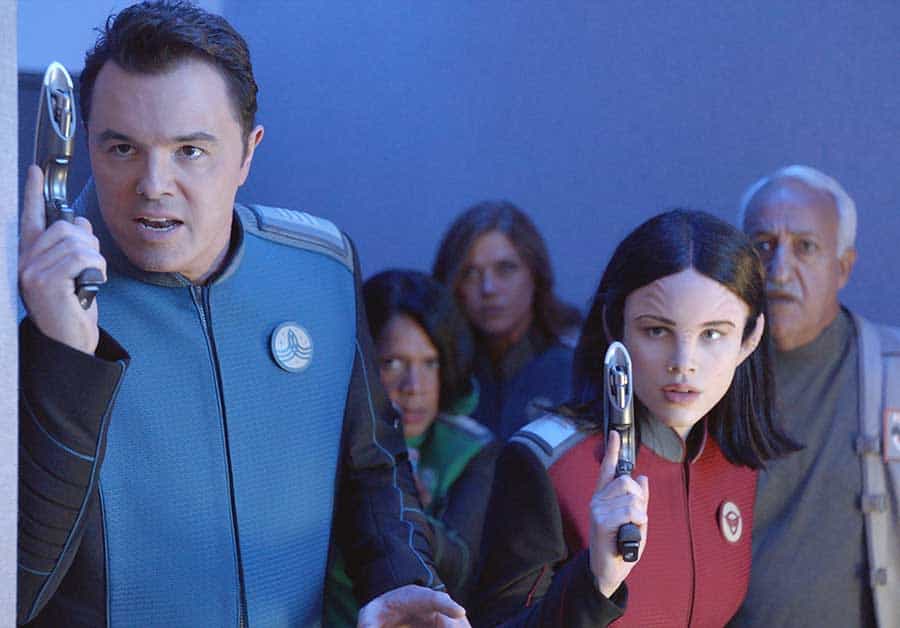
Above: Seth MacFarlane, left, leads the crew and creative effort on the Star Trek homage The Orville. Photo courtesy Fox.
BitDepth#1118 for November 07, 2017
The last two months have been curious ones if you happen to be a Trekkie. And yes, I know Trekker is preferred, but that’s small ting.
There’s been a stunning abundance of Trekfulness (Trekitude?) over the last seven weeks.
Star Trek Discovery is the first flexing of authorial muscle by CBS on the franchise.
The series is set in the legacy Trek universe of Enterprise, Deep Space Nine and Voyager, not the cinematic reboot helmed by Paramount.
Creating a new Trek series in 2017 carries with it the challenge of reconciling the distinctive style of 1966 Star Trek with its painted plywood sets and seat-of-the-pants special effects with today’s expectations of a space adventure, even one created for television.
Official Trek once met this dilemma with good humor in the fifth season time-traveling episode of DS9, Trials and Tribble-ations, which tossed the normally brooding Captain Sisko into an unfamiliar world of miniskirts, beehive hairdos and primary colours.
Discovery, set ten years before the adventures of the original Kirk and Spock, simply ignores a gulf too wide to be explained by logic and embraces much of the effects style of recent Trek films and layers into it a darkness of mood and cinematography that has rarely been part of series canon, save for Borg sets and Cardassian dungeons.
Consider that the series’ hero, the gorgeous Michael Burnham, is introduced to us as a frosty mutineer who triggers a war with almost unrecognizable Klingons.
It takes a while for the series to get its dark and shiny boots unstuck from a depressing world of oppressive military politics and trigger-happy violence, but recent episodes have begun to loosen the death grip on military process to consider the science that’s supposed to be part of this fiction.
Burnham’s anguish over the distance-bending creature tortured with every space jump and a delightful ’Groundhog Day’ episode, taking full advantage of Riann Wilson’s stunning turn as Harcourt Fenton Mudd, suggest there’s more to expect from Discovery than grunting, furious Klingons who have a suspiciously ethnic feel to them.
What’s remarkable about Star Trek Discovery is that it seems populated by characters and not bundles of personality quirks.
Sonequa Martin-Green’s Burnham is Spock’s sister by adoption, raised by Vulcans to rely on cool logic first, but struggling with an empathy she barely understands. Doug Jones’ Saru isn’t just a guy buried in makeup and latex, he’s genuinely otherworldly, a humanoid profoundly out of place among humans.
Mary Wiseman’s Sylvia Tilly is us in space. Unsure, second-guessing herself, unsettled and determined to fit in.
And the captain of this deadly vessel, the tip of the Federation’s wartime spear, is a complete bastard, and Jason Isaacs’s Gabriel Lorca is a soldier first and a human being somewhere much further down in his priorities.
Seth MacFarlane, the creator of Family Guy and other sophomoric fare partnered with Trek alumnus Brannon Braga to take a different angle with The Orville.
You might expect a comedic take on classic Star Trek from the look of the sets, which rather cleverly echo the feel of The Original Series (TOS), as the Shatner Trek is known, but The Orville is both surprisingly heartfelt and painfully wrongheaded.
There is humour, rather a lot of it liberally sprinkled throughout the six episodes aired so far, but the series doesn’t depend on it though it makes for uncertain tone.
There is no lingering on the jokes, no laugh track and a tentative effort at plot and character building in what seemed to be just a Galaxy Quest inspired revisit of the ideas and style of TOS.
The worst thing about The Orville is Seth MacFarlane himself, starring as Captain Ed Mercer. He has never been a particularly interesting actor and despite being dashing in a chubby-cheeked way, isn’t the leading man you want to spend an hour looking at.
He proved that in the promising cowboy satire One Million Ways to Die in the West, which soared on Charlize Theron and crashed and burned on MacFarlane’s hollow leading man presence.
But MacFarlane is smart enough to surround himself with capable actors and to let them have the run of the ship, as it were, receding into the background for long stretches of recent episodes.
In episode seven, Majority Rule, MacFarlane imagines a global political system governed by likes and manages to craft a decent show out of it, something that TOS couldn’t when it painted Frank Gorshin half-black and half-white in the ham-handed anti-racism episode Let that be your last Battlefield.
The Orville’s overriding reason for existence seems to be to complete Kirk’s five-year mission with better sets and a wry smile.
Both series put their crews on ships that aren’t the flagship of their fleets.
Lorca’s Discovery is supposed to be a black-ops research vessel that turns out to be a deadly weapon (it can travel interstellar distances in a blink) and Mercer is trying to advance his career on a small cruiser after a shattering divorce.
Each crew seems aware of the enormous SciFi legacy they are lifting back into prominence (or depending on your perspective, shamelessly ripping off) and their efforts are eminently watchable.
Star Trek Discovery airs first on CBS All Access before streaming on Netflix. The Orville airs on Fox.



